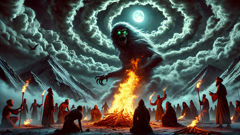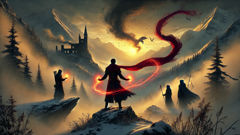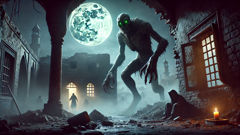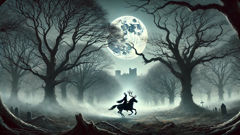Introduction
Beneath the shrouded skies of ancient Iran, when the world was young and the boundaries between myth and reality blurred, there stirred an evil that would become legend. The story begins during the reign of King Zahhak, a name spoken in whispers, for his rule cast a shadow long and cold across the land. Zahhak’s insatiable hunger for power led him to form an army unlike any seen before—one not merely of men, but of monsters conjured from the darkest corners of human fear and imagination. Among these horrors, none was as fearsome or enigmatic as the Patas.
The Patas was said to be born from the collective nightmares of Zahhak’s subjects. Descriptions of the creature varied from village to village, but all agreed on its terror: towering and gaunt, with skin like dried leather stretched across protruding bones, eyes glowing with a venomous green, and a mouth filled with rows of jagged, uneven fangs. It was neither man nor beast, but something in between—a malformed echo of humanity twisted by Zahhak’s dark sorcery. Some believed it could change its shape to slip into shadows; others swore it walked on all fours before rising upright with a shriek that withered crops and curdled milk. Its very presence was a blight, a living omen of Zahhak’s tyranny.
In those days, Iran was a land of splendor and wisdom, renowned for its poets, warriors, and the fertile valleys fed by the sacred rivers. Yet under Zahhak, fear spread like a disease. The Patas and its monstrous kin roamed the countryside, descending upon villages in the dead of night. They carried off the bravest fighters, destroyed grain stores, and left behind trails of destruction and despair. Whole families vanished, and hope became a memory. The wise men and women of the old faith prayed to the ancient gods, but it seemed that even they dared not oppose Zahhak’s monstrous creations.
Still, even in the darkest times, courage can flicker in the unlikeliest hearts. The story of the Patas is not only one of horror, but of resistance. From mountain hamlets to desert oases, whispers grew of heroes and outcasts—of men and women who would not bow before monsters, who sought to break Zahhak’s curse and banish the Patas from their world forever. Their tale is one of sacrifice and cunning, of magic and memory, woven through the tapestry of Iran’s ancient soul. This is the legend of the Patas—a shadow that once ruled the night, and the light that dared to stand against it.
Whispers in the Shadows: The Origin of the Patas
The beginning of the Patas is lost in the folds of forgotten centuries, but fragments remain in the stories passed down by firelight. According to the oldest tales, King Zahhak—corrupted by the serpent’s kiss—was no longer satisfied with human soldiers. He craved loyalty that could not be bought or broken, and so he turned to sorcery as old as the mountains themselves. On a moonless night, Zahhak climbed to the peak of Mount Damavand with his chief magi and a procession of trembling prisoners. There, they performed a ritual as chilling as the mountain winds: sacrificial fires lit the slopes, and the magi chanted words that twisted the very air. From these rites, Zahhak commanded the birth of creatures made of agony and fear—the first of them being the Patas.

The Patas was not born as other living things are. Its form emerged from a swirling miasma, a coalescence of shadows and pain. It howled into existence, a sound so raw it echoed across valleys and sent wolves fleeing for cover. Legend claims that Zahhak himself recoiled at the sight, for the Patas bore a semblance to humanity—twisted and stretched, as if it were a dark mirror held up to his own soul. The creature’s purpose was clear: spread terror, enforce obedience, and crush any flicker of rebellion.
No one knows how many Patas stalked the land, for some say there was only ever one—the first and last of its kind—while others insist there were legions. In the years that followed, wherever the Patas prowled, famine and madness followed. Livestock died in their pens. Children woke screaming from dreams in which the Patas whispered their names. There were stories of it slithering through cracks in doorways, its long arms snaking under beds to drag sleepers into the cold night. Some said it could speak in human voices, mimicking loved ones to lure the unwary from safety.
Yet not all feared it equally. The wise women of the Zagros Mountains, keepers of ancient magic, watched the coming of the Patas with grim resolve. They read the omens in the blood of sacrificed goats and saw that evil, once unleashed, could not be contained by mortal hands alone. A pact was made among them: they would teach those brave enough to resist, sharing charms and knowledge long forbidden. These secrets would become the seeds of rebellion, buried deep beneath Zahhak’s notice. From this clandestine alliance, heroes would one day rise.
As the Patas carried out its master’s will, it grew restless. Hunger gnawed at its spirit, but not for flesh or blood—rather, for the fear that sated its unnatural existence. It haunted the lonely roads between villages, a shifting shadow behind every rustling bush. Hunters who vanished in the woods were said to have met the Patas; only their weapons returned, splintered and stained with black ichor. The monster left behind a trail of folk tales, each more chilling than the last. But as the people’s dread deepened, so too did their yearning for deliverance. In their terror, they whispered of a savior—a champion who would defy the darkness and end the Patas’s reign.
It was in these whispered hopes that the seeds of resistance took root, promising a reckoning for both the monster and the king who commanded it.
The Long Night: The Patas and the Suffering of the People
The years of Zahhak’s tyranny became known as the Long Night, a time when sunlight itself seemed to pale in the face of unending fear. The Patas roamed freely across Iran, serving as both enforcer and symbol of the king’s unassailable power. Its legend grew with each passing season, woven into lullabies meant to keep children indoors after dusk, and warnings etched into doorways in chalk and ash. Villages vanished overnight, their ruins left as mute testimony to the Patas’s passage.

Life under the Patas’s shadow was a careful balancing act for Zahhak’s subjects. In the city of Rey, merchants shuttered their shops before sunset, while farmers in distant valleys left offerings of bread, fruit, and milk at crossroads, hoping to appease the monster. Those who dared to resist—often young men driven by anger or despair—were found days later, marked by a look of terror frozen on their faces. The wise whispered that the Patas did not always kill its victims; some it left alive, their minds shattered by what they had seen.
As the Patas’s power grew, so did Zahhak’s paranoia. The king became obsessed with rumors of rebellion, convinced that his enemies hid behind every smiling face. He commanded his magi to send the Patas on ever more frequent raids, demanding proof of loyalty from even his closest advisors. The monster became a tool not only of terror but of political control. Villagers accused one another of treason to deflect suspicion. Families were torn apart by suspicion and betrayal, as Zahhak’s darkness seeped into the very bones of society.
Yet amid this suffering, glimmers of hope persisted. In the highlands of Luristan, a shepherd named Farhad emerged as an unlikely hero. Having lost his entire family to a Patas raid, Farhad wandered the mountains alone, surviving on roots and wild berries. It was there that he encountered an old woman weaving intricate patterns into a rug by the light of a single oil lamp. She was one of the wise women, and she recognized the fury burning in Farhad’s heart. She taught him ancient words of power, charms to ward off evil, and stories from before the darkness. With her guidance, Farhad fashioned a weapon—a staff tipped with obsidian and bound with silver wire, said to cut through shadows.
Farhad’s defiance was contagious. Word spread of his encounters with the Patas: how he survived a midnight ambush by holding aloft a talisman inscribed with forgotten prayers; how he rescued a group of children from a ruined barn while the monster prowled just beyond the threshold. Each victory, however small, became a rallying cry for others to stand firm. Secret networks formed across Iran, linking villagers and nomads, merchants and outlaws. They shared knowledge—how to recognize signs of the Patas’s approach, which herbs to burn to confuse its senses, which melodies could drive it away for a night. Resistance became a way of life, woven into the fabric of daily existence.
But the Long Night was not easily broken. For every act of bravery, the Patas answered with greater cruelty. It developed new tricks—taking on the forms of loved ones, slipping through cracks in fortified homes, leaving behind tokens that only those marked for death could see. The monster seemed omnipresent, feeding off the people’s dread. Despair threatened to overwhelm even the strongest hearts.
Still, the people endured. In their stories and songs, they remembered that monsters could be fought, if not always defeated. The Patas, for all its might, could not extinguish hope completely. It was this stubborn refusal to surrender, this ember of resilience glowing in the darkness, that would one day turn the tide.
The Hero’s Gambit: Farhad, Sorcery, and the Fall of the Patas
In the heart of winter, as snow draped the mountains in mournful silence, Farhad’s quest against the Patas reached its climax. He had become a symbol of resistance—his name whispered with reverence and hope across the land. Yet victory remained elusive. The wise woman had warned him: to destroy a monster born of fear, he would need more than weapons or cunning; he would need to face his own nightmares and outwit the sorcery that bound the Patas to Zahhak’s will.

For months, Farhad wandered the land, gathering allies: a mute archer from Susa whose arrows could find any target; a healer from Shiraz who brewed potions against dark magic; and an old poet from Isfahan whose riddles could confound even demons. Together, they mapped the monster’s patterns and traced its movements to the heart of Zahhak’s domain—a fortress built from black basalt, perched atop a cliff where vultures circled endlessly. It was here that the Patas returned after every raid, drawn back by a spell inscribed in blood upon the throne room floor.
Farhad’s plan was simple but perilous: lure the Patas away from its lair, sever its connection to Zahhak’s magic, and trap it where it could no longer harm the innocent. The wise woman had given him a final charm—a woven cord dyed crimson, said to bind even spirits if wielded with a pure heart. With his allies at his side, Farhad set his trap near a lonely crossroads where many had vanished before.
The battle that followed was one for the ages. As dusk fell, a chill wind swept through the valley and the Patas appeared, drawn by the scent of fear and the promise of prey. It came in its true form: a thing of bones and sinew, eyes aglow with an unnatural light. Farhad stood his ground as the monster lunged, its claws slashing through the air. The archer’s arrows struck home, but did not slow it; the healer’s potions hissed against its hide, but failed to wound. Only when Farhad spoke the secret words taught by the wise woman did the Patas falter.
In that moment, Farhad saw the creature for what it truly was: not merely a beast, but a vessel for every fear Zahhak had sown in his people. With trembling hands, Farhad looped the crimson cord around the Patas’s neck and whispered the ancient prayers. The monster thrashed and shrieked, its voice shifting between human agony and animal rage. The earth trembled beneath their feet as shadows boiled across the crossroads. But Farhad held fast, calling upon the memory of all he had lost—and all that still needed protecting.
As dawn broke over the mountains, the Patas collapsed in a heap, its monstrous form dissolving into mist and ash. The spell binding it to Zahhak shattered, sending ripples of energy across the land. For the first time in generations, silence returned to the valleys—no longer filled with fear, but with hope. Farhad’s victory was not without cost. Many of his allies had fallen or vanished, and he bore scars both seen and unseen. But his courage had broken the Long Night’s grip and proved that even monsters born of despair could be banished by those who dared to resist.
Word of the Patas’s defeat spread quickly. Villagers emerged from hiding to rebuild what had been lost. Songs were sung in Farhad’s honor, and old charms were replaced with symbols of renewal and peace. Zahhak’s power began to wane, as fear no longer held his kingdom in thrall. The legend of the Patas passed into myth—but its shadow lingered as a reminder of what people could endure, and what they could overcome.
Conclusion
The story of the Patas endures in the memory of Iran’s mountains and deserts—a legend of darkness and deliverance. Though centuries have passed since Zahhak’s reign, villagers still speak of nights when shadows move too quickly or nightmares seem too real. Some say the Patas was destroyed forever; others claim its spirit lingers, waiting for fear to give it new life. Yet even as its legend endures, so too does the lesson learned by Farhad and his people: that even the most fearsome monster is powerless before the courage of those who stand together.
In every retelling, the Patas shifts shape—sometimes a beast, sometimes a wraith, sometimes a reflection of tyranny itself. Its defeat is celebrated not just as a victory over evil, but as a testament to resilience and hope. Children learn that monsters may haunt the world, but they can be faced and overcome with wisdom and unity. As long as people remember to share these stories—around fires, beneath ancient stars—the shadow of the Patas will never fall unchecked again.
Thus, the legend weaves itself into the tapestry of Iranian folklore: a warning against cruelty, a tribute to those who resist oppression, and a promise that even in the darkest hour, light can be found if one is brave enough to seek it.













